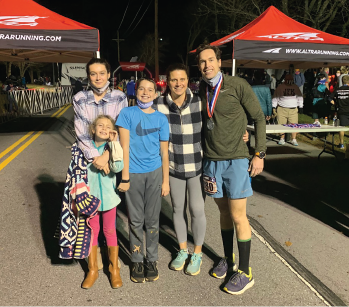Athletic Training and Medical Professionalism
Dr. Daniero had been a casual runner and was never a high school varsity athlete. Nonetheless, in his late 30s, he chose to transition from competing in sprint triathlons (with a half-mile swim, a 12-mile bike ride, and a 3.1-mile run) and half marathons (about 13 miles) to focus on longer races. The scientific possibility of what the body could do appealed to him.
Explore This Issue
May 2021
Jim Daniero, MD, celebrates with his family after completing the 2020 JFK 50 Mile race in 10 hours.
© Courtesy Jim Daniero, MD
“It’s more of a mind game: the discipline of training, and knowing the nutritional science and the scientific approach of trying to push the limits of human endurance, that really resonated with me,” he said. “It requires certain commitments and understanding of how to run that far and how to recover from it. Some of the training seems counterintuitive, such as not necessarily going all out when leading up to a long race to avoid injury on race day, making sure not to overtrain, and knowing how to go back to a healthy base from where you can extend into another race or training session during the year,” he said. “That really captured me.”
Dr. Daniero, who is chair-elect of the American Academy of Otolaryngology–Head and Neck Surgery’s Voice Committee and chair of the American Laryngological Association Post-Graduate Member Steering Committee, will think through work issues while out on his long runs, which he frequently does on familiar trails with a GPS watch and a headlamp to see at night or in the pre-dawn morning. He has especially appreciated being able to run solo outside in the woods without a mask during the COVID-19 pandemic. “I’ve found that a lot of my ‘aha!’ moments, both in research and on the clinical side, come when I’m doing long runs—just me in my own head for two hours,” he said.
Dr. Miller believes that engaging in team sports—he played baseball, swam in high school, and was a swim team captain for two years—helped make him into a better doctor. “When you function as a team, you need to learn how to work with others—when to take control and when to step back,” he said. “In medicine today, the same principles apply: You’re always functioning as part of a group, each person with his or her own expertise. When managing a complex head and neck patient requiring facial nerve reconstruction, you need to work alongside the cancer surgeon, oncologist, radiation oncologist, and so many others to provide the patient with the best possible outcome. At the end of the day, that’s what matters.”